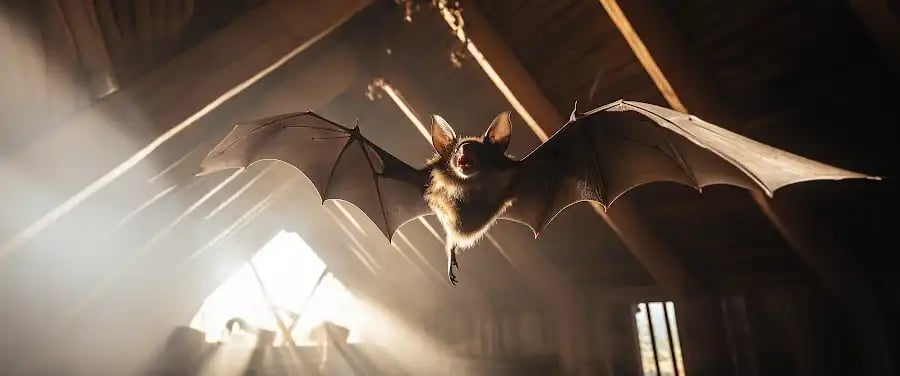
There’s something truly glorious about a summer sunset as it slides languidly beneath the horizon. It’s a moment of serenity, a pause in the hustle of the day, as the sky unfurls its dusky palette, painting shades of rose and amethyst in a steadily dimming canvas. But whilst you’re mesmerized by this brushstroke of nature, out from the dark recesses of your home, a hidden intruder emerges, preparing for its nightly forage. Yes, my friends, I am talking about bats.
Now, don’t get me wrong. Bats are fascinating creatures, playing an integral role in our ecosystem. They are avid insectivores, and plant pollinators – their existence ensures the balance of our biodiversity. Yet, cohabitating with these winged wonders is not exactly ideal, if not downright unsettling for most homeowners. So sit tight, because we’re not talking bat caves of Gotham City. In this article, we’re going to delve into the nitty gritty of bat-proofing your humble abode.
It might sound like a daunting task at first. After all, how do you make your home unattractive to a creature that loves the darkness as much as a bat? Knowledge, my friend, is our strongest weapon. By understanding what attracts these nightly visitors, we can implement measures that will discourage their uninvited residence in our homes. So buckle up! Because doing a little detective work now can save you from the unpleasant surprise of a bat invasion later. Fasten your seatbelts as we prepare to take off on the exciting journey of making your house less of a Batcave and more of home-sweet-home.
Now that you are hooked, let’s glide into our main topic, “Why should you bat-proof your house?” And trust me, it’s not just about avoiding an unexpected encounter with these creatures in the dead of night.
Understanding Bats: Behavior, Habits, and Patterns

When it comes to wildlife and your home spaces, certain creatures might seem a bit more unnerving than others. Top on that list recently? Bats. Often, they sneak into the warm and cozy crevices of your house for shelter, giving you unexpected roommates. Armed with an understanding of bat behavior, patterns, and the various types of bats that frequent residential areas, you can take actionable steps to seal your home against bats.
Bats, in general, are creatures of habit. Their species get determined by their nesting habits, diet, and, interestingly, their behavior during different weather conditions. The Big Brown Bat and the Little Brown Bat are the most common types that you may find in a residential scenario, especially in North American homes.
Why do they venture so close? Bats are nocturnal creatures, and their timing is primarily driven by food availability. They are most active during warm months such as summer and early fall. This is when bugs and insects, their primary source of food, are abundant. In colder times, bats hibernate or migrate depending on their species due to a scarcity of food.
Their unique habits and the cyclical nature of their active periods are essential to note when planning to seal your home against bats. How do bats find their entrances you ask? That’s a different story altogether!
Did you know that a single bat can consume up to 1,200 mosquito-sized insects every hour? Indeed, bats play a vital role in maintaining balance in our ecosystem, a fact verified by the National Wildlife Federation.
And now onto the next topic, How do bats find their way into homes? Understanding this will be crucial in our mission to bat-proof our homes.
How Do Bats Find Their Way Into Homes?

Bats have an uncanny knack for locating tiny openings and crevices into homes. They use these entry points to seek warmth and shelter, often making attics, chimneys, and other enclosed areas their nesting ground. Let’s explore how you can determine if these elusive creatures have taken up residence in your space.
Locating Common Entry Points for Bats
Bats are capable of squeezing through spaces as small as half an inch. Familiarize yourself with potential bat entry points by thoroughly inspecting your home’s exterior. Look for visible gaps or holes in the roofline, siding, attic vents, and windows. Other favorite entry points for bats include chimneys, loose or missing roof shingles, and under doorframes. It’s important to check these areas during the day when bats are less active.
Detecting Signs of Bat Invasions
Bats, although silent and unassuming, leave behind unmistakable signs of their presence. If you notice a growing number of those tiny brown creatures hanging around your property in the evening, it’s a clear indication of a bat invasion. Other signs include dark discolorations around potential entry points caused by bat oils.
One of the most reliable signs is the presence of bat guano (bat droppings). Bat guano is easily identifiable due to its distinct smell and small, dark pellet-like appearance.
Recognizing Bat Sightings and Sounds
Aside from physical signs, bat sightings and sounds can also signal their presence. Bats are primarily nocturnal, so if you spot one fluttering around your home at dusk, there’s a good chance they’re roosting nearby.
When it comes to sounds, bats emit a series of high-pitched squeaks and rustling noises. Keep an ear out for these sounds at night, particularly coming from your attic or within your walls.
For more comprehensive information on bats, their habits, and the signs of their presence, you can visit the National Pest Management Association.
Our transition to the next topic is to discuss strategies and how to seal your home against bats. Understanding how bats enter your home is the first step. The next step is learning effective steps to fend them off. Stay tuned for tips on bat-proofing your home.
How Can You Prevent Bats From Entering Your Home?

There’s a good chance your home might have turned into the perfect bat hotel without you even knowing it. But don’t fret, with a few adjustments, you can learn how to seal your home against bats. By taking precautionary measures, you can easily prevent these winged visitors from sharing your home.
Steps for Bat-Proofing the Exterior of Your Home
- 1
Identifying Potential Entry Points
The first step in exterior bat-proofing is to identify potential entries. Most bats can squeeze into tiny gaps as small as 3/8 of an inch. Look for holes and cracks in your roof, eaves, fascia boards, and walls. Basically, any spot that allows for a bat to crawl into your house.
- 2
Discussing Bat-Proofing Materials
Next, consider the bat-proofing materials at your disposal. You want materials that effectively block off entrances while not trapping bats inside. Polyurethane sealant or expanding foam insulation can be useful for filling gaps and cracks. For bigger spaces, you may want to utilize chimney caps, window screens, and draft guards.
- 3
Sealing Roofs and Walls Securely
In sealing roofs, pay special attention to dormers, ridge caps, skylights, and attic vents. This also applies to outside walls, especially where siding and chimneys meet. These are common spots where bats can slide their way into your home.
- 4
Addressing Vents, Chimneys, and Other Open Areas
Securing vents, chimneys, and other open areas can not be overstated. Ensure to cover them with durable mesh screens. However, be extra careful while dealing with chimneys. It’s best to install a one-way exclusion door if you suspect a bat might currently be residing there.
- 5
Highlighting Regular Maintenance for Long Term Prevention
Regular maintenance is key to prevent bat re-entry. Keep an eye on previously sealed spots and fix any wear and tear promptly.
Steps for Bat-Proofing the Interior of Your Home
- 1
Bat-Proofing Attics and Basements
For interior bat-proofing, focus on attics and basements. Bats adore these secluded spots. Inspect for any holes or cracks where light can seep through and promptly seal them.
- 2
Sealing Cracks and Crevices
Sealing cracks and crevices is crucial. You can use an expanding foam sealant or caulking gun for the task. Remember, a small breach can let many bats in.
- 3
Using Ultraviolet Light to Deter Bats
Ultraviolet light is known to deter bats. While scientists are yet to understand why, adding several UV lights could make your house less appealing to bats.
- 4
Evaluating Bat Repellents and Their Effectiveness
Lastly, consider bat repellents. However, their effectiveness is somewhat controversial. Studies have shown mixed results, but some homeowners swear by them.
Landscaping Tips for Bat Prevention
- 1
Making Your Yard Unattractive to Bats
First, make your yard unappealing to bats. Eliminate any potential shelter spots, like loose bark or garden sheds. Remember, bats prefer nesting in elevated areas with plenty of hiding spaces.
- 2
Using Lights to Deter Bats
As with UV lights, ordinary lights can also deter bats. Consider using strong landscaping lights in parts of your yard that could potentially serve as shelter for bats.
- 3
Controlling Insects That Attract Bats
Finally, control insects that attract bats. Regular pest control or using plants that naturally repel insects could make your yard less attractive to our nocturnal visitors.
- 4
Evaluating Bat Repellents and Their Effectiveness
Lastly, consider bat repellents. However, their effectiveness is somewhat controversial. Studies have shown mixed results, but some homeowners swear by them.
To sum up, bat-proofing doesn’t entail a one-time solution. It requires regular inspection and maintenance. By following these instructions on how to seal your home against bats, your house should remain bat-free. Now, let’s move to the subsequent topic, which is about ” How to safely remove bats from your home”.
Conclusion
Bats may be an essential part of our ecosystem, providing necessary bug control, but many homeowners don’t exactly want them nesting in their houses. If you find yourself cohabitating with bats, learning how to seal your home against bats is crucial to safeguard your space from these nocturnal creatures. Here’s a step-by-step guide for you to master the art of bat-proofing your home.
Identify the Bats’ Entry Point
Bats are capable of squeezing through incredibly tiny gaps – as small as half an inch, so thoroughly examine your attic, basement, and walls for any potential openings. Look for their tell-tale signs, such as grease marks around small holes or cracks, or tiny droppings also known as guano.
Bat-proof During the Right Season
Interestingly, the time of the year matters in bat-proofing your home. Late summer to early autumn is usually the best time to seal your house against bats. This is the period when baby bats can fly independently and leave their nest, ensuring you won’t accidentally trap any inside your home. You should strictly avoid bat-proofing during maternity season, typically around May to August, to prevent leaving behind baby bats.
Sealing all Points of Entry
Once you’ve identified the bats’ entrances and exits and have waited for the right season, it’s time to seal these gaps. For small openings, a simple weather-stripping adhesive or a high-quality caulk might suffice. However, for bigger holes, you should consider using sturdy materials like hardware cloth or heavy-duty netting. Remember to secure all vents, windows, chimneys, and other potential entry points.
Install One-Way Bat Doors
Before you seal every opening, it’s crucial to ensure all bats have left your home. To do that, install one-way bat doors, which allow bats to leave but prevent them from re-entering. Once you are sure the bats have vacated, these doors can be removed and permanently sealed.
Regular Checkups & Maintenance
Post bat-proofing, ensure to check your home frequently for any signs of re-infestation. This maintenance step is important as bats might find new entry points over time.
While these are the key steps to sealing your home against bats, you might still need professional help in some cases. Make sure the professional you hire uses humane methods to remove bats, as many species are protected by law.
It’s important to remember that bats are beneficial to our environment, even if they’re not so beneficial to our homes. Bat-proofing not only helps keep your home bat-free, but it also promotes the survival of these significant creatures in their natural habitats, where they can continue keeping our ecosystem balanced.
Remember that mastering the art of bat-proofing doesn’t just involve understanding how to seal your home against bats. It also includes understanding the creatures themselves and the pinnacle role they play in our world. With these tips, you can protect your home, while also preserving the bat population—a win-win situation!



